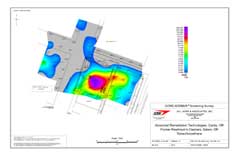|
|
Former Dry Cleaners
Salem, Oregon

ART was retained the consultant and remediation contractor for completing the investigation and cleanup of a historical solvent release from an industrial dry cleaners facility. The site is within the DEQ’s Voluntary Cleanup Program. From at least mid 1930’s until 1991, the site’s use was an industrial laundry facility. Over the time period of operation, the facility utilized both Stoddard solvent and tetrachloroethylene (commonly referred to as PERC or PCE). Stoddard solvent was replaced as the cleaning solvent by PCE in the late 1950’s. The Stoddard solvent was stored in underground storage tanks (USTs). PERC was stored in an above ground container, normally a 55-gallon drum, located near the dry cleaning equipment. ART conducted a passive VOC-vapor sampling survey to evaluate tetrachloroethylene (PCE) impacts to soil and groundwater. The survey was used to determine if significant impacts existed both on and offsite and narrow a more quantitative investigations at the site.

Based on results of the soil gas survey, ART conducted a boring program on-site and off-site to further evaluate the horizontal and vertical extent of groundwater contamination. Borings were advanced down to the top of the first competent layer of fine-grained material beneath the site. Lithology at the site is described as difficult for conventional drilling techniques (unconsolidated sandy gravel with cobbles and boulders), therefore a sonic drill rig was used to complete the borings and install the monitoring wells at the site. The sonic drill uses high frequency mechanical oscillations, developed in the special drill head, to transmit resonant vibrations and rotary power through the drill tooling to the drill bit allowing it to achieve exceptional drilling penetration rates without the need for drilling fluids or air to effectively take overburden core samples. The core samples were analyzed to provide a precise and detailed stratigraphic profile of overburden condition including dry or wet saturated sands and gravels, cobbles and boulders, clays, silts and hard tills. Recovery of samples was consistently close to 100%.
Upon completion of the site characterization, ART completed a risk assessment (RA) and focused feasibility study (FS). The RA determined that the risks were primairily associated with soil vapor and vapor intrusion within occupational exposure. The FS then focused on reduction of these risk exposure pathways and evaluated various alternatives based on cost and effectiveness. Based on the FS an interim remedial action measure (IRAM) was proposed and implemented for the site.
ART operated an IRAM to address the PCE release area beneath the building. The IRAM has remediated the vadose zone soils and saturated soils within the level of groundwater fluctuation to reduce leaching to groundwater (a continued source to groundwater contamination). The IRAM has effectively reduced the concentrations to below target levels and was monitored for rebound and now is under review for closure status. ART has maintained a quarterly groundwater monitoring program to establish groundwater flow and gradient, as well as assisting in evaluating risk associated with the groundwater plume. The site has been sold for redevelopment with street level retail and residential above within the city’s historical reutilization district.

|

